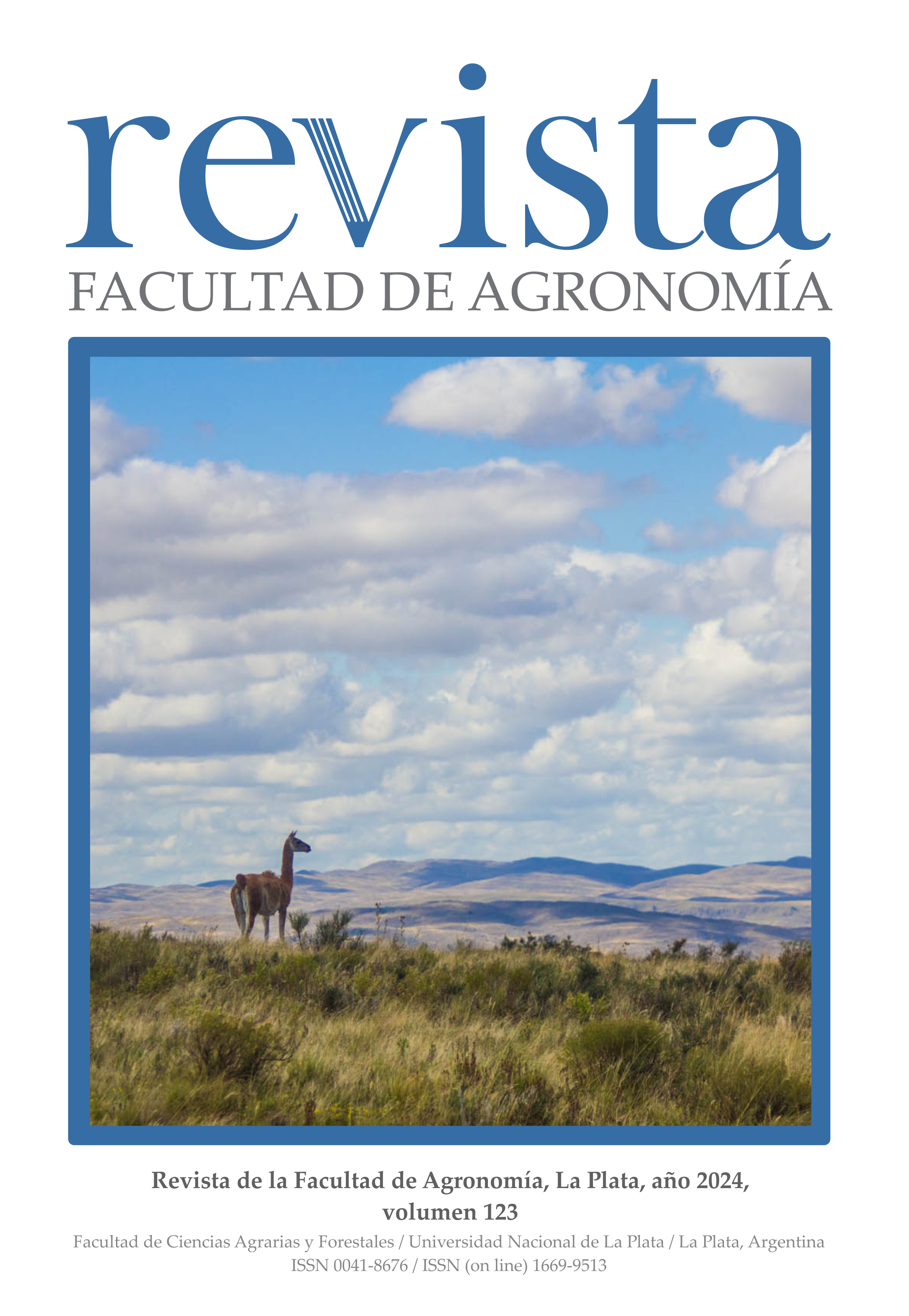Control biológico por conservación: conceptos clave, estrategias y avances para construir una agroecología sostenible
DOI:
https://doi.org/10.24215/16699513e143Palavras-chave:
memoria ecosistémica, control biológico por conservación, enemigos naturalesResumo
El control biológico por conservación (CBC) ofrece un camino prometedor para las nuevas prácticas agroecológicas sostenibles que permitan hacer un uso razonable de los recursos disponibles. Estas prácticas involucran la participación de múltiples áreas del conocimiento que convergen con el fin de asegurar la coexistencia entre las actividades agropecuarias y el ecosistema que las rodea. En este escenario, los insectos cumplen un rol fundamental como principales depredadores/parasitoides de otros insectos que son plagas de cultivos. Entender las múltiples y variadas interacciones que tienen lugar en los campos de cultivo es cruciales para las investigaciones en control biológico. Esto permitiría tomar medidas de control sin descuidar el equilibrio de estos ecosistemas. Por esta razón gran parte de los esfuerzos de estas prácticas están relacionadas a la conservación y protección de los insectos. En este trabajo se busca hacer un resumen de la literatura más reciente sobre los conceptos relacionados al CBC, su implicancia económica y las proyecciones futuras.
Downloads
Referências
Abdallah, F., Ghanim, A., El-Serafi, H. A. K. y Al-Damrawy, M. A. (2019). Effect of different Planting Dates on the Occurrence of Main Predators Inhabiting Five Maize Varieties. Journal of Plant Protection and Pathology, 10, 427–430. https://doi.org/10.21608/jppp.2019.59758
Arcusa, J. M. (2016). Efecto de un incendio sobre el ensamble de hormigas de la Reserva Natural Privada Paititi, Provincia de Buenos Aires, Argentina. Revista de la Sociedad Entomologica Argentina, 75(3-4), 127-134.
Aydoğan, Z., Gürol, A. y Incekara, Ü. (2016). The investigation of heavy element accumulation in some Hydrophilidae (Coleoptera) species. Environmental Monitoring and Assessment, 188, 204. https://doi.org/10.1007/s10661-016-5197-3
Barbosa, P. A. (1998). Conservation Biological Control. Elsevier.
Baker, B. P., Green, T. A. y Loker, A. J. (2020). Biological control and integrated pest management in organic and conventional systems. Biological Control, 140, 104095. https://doi.org/10.1016/j.biocontrol.2019.104095
Berensztein, D., Ricci, M., Polack, L. A. y Edith, M. (2017). Control biológico por conservación: evaluación de los enemigos naturales de Brevicoryne brassicae (Hemiptera: Aphididae) en un manejo agroecológico de producción al aire libre de repollo (Brassica oleracea) del Cinturón Hortícola de La Plata, Buenos Aires, Argentina. Revista de la Facultad de Agronomía, 116(1), 141- 154.
Bergeron, J. A. C., Pinzon, J., Odsen, S., Bartels, S., Macdonald S. E. y Spence, J. R. (2017). Ecosystem memory of wildfires affects resilience of boreal mixedwood biodiversity after retention harvest. Oikos, 126, 1738–1747. https://doi.org/10.1111/oik.04208
Buchori, D., Rizali, A., Priawandiputra, W., Sartiami, D. y Johannis, M. (2019). Population Growth and Insecticide Residues of Honeybees in Tropical Agricultural Landscapes. Diversity, 12,1. https://doi.org/10.3390/d12010001
Buxton, M., Cuthbert, R. N., Dalu, T., Nyamukondiwa C. y Wasserman, R. J. (2020). Complementary impacts of heterospecific predators facilitate improved biological control of mosquito larvae. Biological Control, 144, 104216. https://doi.org/10.1016/j.biocontrol.2020.104216
Castro, A. V., Porrini, D. P., Lupo, S. y Cicchino, A. C. (2020). Minimal stories in Southeast Buenos Aires grasslands: carabid beetle biodiversity throughout an urban-rural gradient. Urban Ecosystems, 23, 331–343. https://doi.org/10.1007/s11252-019-00925-y
Cruz, R., De Castro, I. y Sáez, R. (2018). Los costos de producir soja en las pequeñas empresas chaqueñas. Argentina. Revista de la Facultad de Ciencias Económicas de la UNNE, 19, 135-149. https://doi.org/10.30972/rfce.0192861
Culshaw‐Maurer, M., Sih, A. y Rosenheim, J. A. (2020). Bugs scaring bugs: enemy‐risk effects in biological control systems. Ecology Letters, 23, 1693–1714. https://doi.org/10.1111/ele.13601
de Souza Pacheco, I., Manzano Galdeano, D., Spotti Lopes, J. R. y Machado, M. A. (2020). Development on infected citrus over generations increases vector infection by ‘Candidatus Liberibacter Asiaticus’ in Diaphorina citri. Insects, 11(7), 469. https://doi.org/10.3390/insects11080469
Diepenbrock, L. M., Fothergill, K., Tindall, K. V., Losey, J. E., Smyth, R. R. y Finke, D. L. (2016). The Influence of Exotic Lady Beetle (Coleoptera: Coccinellidae) Establishment on the Species Composition of the Native Lady Beetle Community in Missouri. Environmental Entomology, 45, 855–864. https://doi.org/10.1093/ee/nvw065
Drossart, M. y Gérard, M. (2020). Beyond the decline of wild bees: Optimizing conservation measures and bringing together the actors. Insects, 11(9), 649. https://doi.org/10.3390/insects11090649
Duval, V. S. y Benedetti, G. M. (2019). Política de conservación del patrimonio natural en Argentina. Finisterra, 54(111), 101-118. https://doi.org/10.18055/Finis17108
Echeverría, M. L., Alonso, S. I. y Comparatore, V. M. (2017). Survey of the vascular plants of Sierra Chica, the untouched area of the Paititi Natural Reserve (southeastern Tandilia mountain range, Buenos Aires province, Argentina). Check List, 13(6), 1003-1036. https://doi.org/10.15560/13.6.1003
Ehler, L. E. (1998). Conservational Biological Control: Past, present and future. En P. A. Barbosa (Ed.), Conservation Biological Control (pp. 1-8). Elsevier.
Gontijo, L. M. (2019). Engineering natural enemy shelters to enhance conservation biological control in field crops. Biological Control, 130,155–163. https://doi.org/10.1016/j.biocontrol.2018.10.014
Gutiérrez, J. L. y Jones, C. G. (2008). Ecosystem Engineers. En J. Wiley & Sons (Eds.), Encyclopedia of Life Sciences. Wiley. https://doi.org/10.1002/9780470015902.a0021226
Harris, J. E., Rodenhouse, N. L. y Holmes, R. T. (2019). Decline in beetle abundance and diversity in an intact temperate forest linked to climate warming. Biological Conservation, 240, 108219. https://doi.org/10.1016/j.biocon.2019.108219
Hendges, C., Schiller, A. D. P., Manfrin, J., Macedo Jr., E. K., Gonçalves Jr., A. C. y Stangarlin, J. R. (2019). Human intoxication by agrochemicals in the region of South Brazil between 1999 and 2014. Journal of Environmental Science and Health, Part B, 54(4), 219-225. https://doi.org/10.1080/03601234.2018.1550300
Holland, J., Jeanneret, P., Moonen, A. C., van der Werf, W., Rossing, W., Antichi, D., Entling M., Giffard B., Helsen, H., Szalai, M., Rega, C., Gibert, C. y Veromann E. (2020). Approaches to Identify the Value of Seminatural Habitats for Conservation Biological Control. Insects, 11, 195. https://doi.org/10.3390/insects11030195
Holmes, L., Upadhyay, D. y Mandjiny, S. (24-26 de febrero de 2016). Biological control of agriculture insect pests [Conferencia]. 2nd Pan-American Interdisciplinary Conference. European Scientific Institute. Buenos Aires, Argentina.
Homburg, K., Drees, C., Boutaud, E., Nolte, D. Schuett, W., Zumstein, P., Ruschkowski, E. y Assmann, T. (2019). Where have all the beetles gone? Long‐term study reveals carabid species decline in a nature reserve in Northern Germany. Insect Conservation and Diversity,12(4), 268- 277. https://doi.org/10.1111/icad.12348
Huang, J., Zhou, K., Zhang, W., Deng X., Van der Werf, W., Lu, Y., Wu, K. y Rosegrant, M. W. (2018). Uncovering the economic value of natural enemies and true costs of chemical insecticides to cotton farmers in China. Environmental Research Letters, 13(6), 064027. https://doi.org/10.1088/1748-9326/aabfb0
Huikkonen, I. M., Helle, I. y Elo, M. (2020). Heterogenic aquatic vegetation promotes abundance and species richness of Odonata (Insecta) in constructed agricultural wetlands. Insect Conservation and Diversity, 13(4), 374-383. https://doi.org/10.1111/icad.12396
Jirón-Pablo, E., Martínez-Martínez, L. y Sánchez-García, J. A. (2018). First record of toxomerus politus1 larvae preying on sentinel eggs of spodoptera frugiperda2 on Maize. Southwestern Entomologist, 43(2), 511-515. https://doi.org/10.3958/059.043.0222
Jones, M.S., Fu, Z., Reganold, J.P., Karp, D.S., Besser, T.E., Tylianakis, J.M. y Snyder, W.E. (2019). Organic farming promotes biotic resistance to foodborne human pathogens. Journal of Applied Ecology, 56(5), 1117-1127. https://doi.org/10.1111/1365-2664.13365
Jones, M. S., Wright, S. A., Smith, O. M., Besser, T. E., Headrick, D. H., Reganold, J. P., Crowder, D. W. y Snyder, W. E. (2019). Organic farms conserve a dung beetle species capable of disrupting fly vectors of foodborne pathogens. Biological Control 137, 104020. https://doi.org/10.1016/j.biocontrol.2019.104020
Jonsson, M., Kaartinen, R. y Straub, C. S. (2017). Relationships between natural enemy diversity and biological control. Current Opinion in Insect Science, 20, 1-6. https://doi.org/10.1016/j.cois.2017.01.001
Koch, R. L., Venette, R. C. y Hutchison, W. D. (2006). Invasions by Harmonia axyridis (Pallas) (Coleoptera: Coccinellidae) in the western hemisphere: implications for South America. Neotropical Entomology, 35(4), 421-434. https://doi.org/10.1590/S1519-566X2006000400001
Krause-Sakate, R., Watanabe, L. F. M., Gorayeb, E. S., da Silva, F. B., Alvarez, D. de L., Bello, V. H., Nogueira, A. M., de Marchi, B. R., Vicentin, E., Ribeiro-Junior, M. R., Marubayashi, J. M., Rojas-Bertini, C. A., Muller, C., Bueno, R. C. O. de F., Rosales, M., Ghanim, M. y Pavan, M. A. (2020). Population dynamics of whiteflies and associated viruses in South America: Research progress and perspectives. Insects, 11(12), 847. https://doi.org/10.3390/insects11120847
Kruitwagen, A., Beukeboom, L. W. y Wertheim, B. (2018). Optimization of native biocontrol agents, with parasitoids of the invasive pest Drosophila suzukii as an example. Evolutionary Applications, 11(8), 1473–1497. https://doi.org/10.1111/eva.12648
La Notte, A., D’Amato, D., Mäkinen, H., Paracchini, M.L., Liquete, C., Egoh, B., Geneletti, D. y Crossman, N. D. (2017). Ecosystem services classification: A systems ecology perspective of the cascade framework. Ecological Indicators, 74, 392–402. https://doi.org/10.1016/j.ecolind.2016.11.030
Leather, S. R. (2018). “Ecological Armageddon” - More evidence for the drastic decline in insect numbers: Insect declines. Annals of Applied Biology, 172(1), 1–3. https://doi.org/10.1111/aab.12410
Lehmitz, R., Haase, H., Otte, V. y Russell, D. (2020). Bioindication in peatlands by means of multitaxa indicators (Oribatida, Araneae, Carabidae, Vegetation). Ecological Indicators, 109, 105837. https://doi.org/10.1016/j.ecolind.2019.105837
Lester, P. J. y Beggs, J. R. (2019). Invasion success and management strategies for social Vespula wasps. Annual Review of Entomology, 64, 51–71. https://doi.org/10.1146/annurev-ento-011118-111812
Marazzi, L., Gaiser, E., Eppinga, M., Sah, J., Zhai, L., Castañeda-Moya, E. y Angelini, C. (2019). Why do we need to document and conserve foundation species in freshwater wetlands? Water, 11(2), 265. https://doi.org/10.3390/w11020265
Monzó, C. y Stansly, P. A. (2020). Economic value of conservation biological control for management of the Asian citrus psyllid, vector of citrus Huanglongbing disease. Pest Management Science, 76(5), 1691–1698. https://doi.org/10.1002/ps.5691
Ogle, K., Barber, J. J., Barron-Gafford, G. A., Bentley, L. P., Young, J. M., Huxman, T. E., Loik, M. E., y Tissue, D. T. (2015). Quantifying ecological memory in plant and ecosystem processes. Ecology Letters, 18(3), 221–235. https://doi.org/10.1111/ele.12399
Organización de las Naciones Unidas. (s.f.). ONU. Objetivos de desarrollo sostenible. UN. Recuperado en 2024 de https://www.un.org/sustainabledevelopment/es/objetivos-de-desarrollo-sostenible/
Padisák, J. (1992). Seasonal succession of phytoplankton in a large shallow lake (Balaton, Hungary) – A dynamic approach to ecological memory, its possible role and mechanisms. The Journal of Ecology, 80(2), 217–230. https://doi.org/10.2307/2261008
Paredes, D., Karp, D. S., Chaplin-Kramer, R., Benítez, E. y Campos, M. (2019). Natural habitat increases natural pest control in olive groves: Economic implications. Journal of Pest Science, 92(3), 1111–1121. https://doi.org/10.1007/s10340-019-01104-w
Peacor, S. D., Barton, B. T., Kimbro, D. L., Sih, A. y Sheriff, M. J. (2020). A framework and standardized terminology to facilitate the study of predation risk effects. Ecology, 101(12), e03014. https://doi.org/10.1002/ecy.3152
Peñalver-Cruz, A., Alvarez-Baca, J. K., Alfaro-Tapia, A., Gontijo, L. y Lavandero, B. (2019). Manipulation of agricultural habitats to improve conservation biological control in South America. Neotropical Entomology, 48(5), 875–898. https://doi.org/10.1007/s13744-019-00725-1
Pereyra, P. J. (2016). Revisiting the use of the invasive species concept: An empirical approach. Austral Ecology, 41(4), 519–528. https://doi.org/10.1111/aec.12340
Peterson, G. D. (2002). Contagious disturbance, ecological memory, and the emergence of landscape pattern. Ecosystems, 5(4), 329–338. https://doi.org/10.1007/s10021-001-0077-1
Rodríguez, J. R., Rossetti, M. R. y Videla, M. (2019). Agroecológicas de Córdoba, Argentina. Revista de la Facultad de Ciencias Agrarias, 11(1), 265–275.
Rossetti, M. F., Stoker, C. y Ramos, J. G. (2020). Agrochemicals and neurogenesis. Molecular and Cellular Endocrinology, 510, 110820. https://doi.org/10.1016/j.mce.2020.110820
Salas Gervassio, N. G., Luna, M. G., Lee, S., Salvo, A. y Sánchez, N. E. (2016). Trophic web associated with the South American tomato moth Tuta absoluta: Implications for its conservation biological control in Argentina. Agricultural and Forest Entomology, 18(2), 137–144. https://doi.org/10.1111/afe.12146
Sánchez-Bayo, F. y Wyckhuys, K. A. G. (2019). Worldwide decline of the entomofauna: A review of its drivers. Biological Conservation, 232, 8–27. https://doi.org/10.1016/j.biocon.2019.01.020
Saqib, H. S. A., Chen, J., Chen, W., Pozsgai, G., Akutse, K. S., Ashraf, M. F., You, M. y Gurr, G. M. (2020). Local management and landscape structure determine the assemblage patterns of spiders in vegetable fields. Scientific Reports, 10(1), 15130. https://doi.org/10.1038/s41598-020-71888-w
Schifani, E., Castracani, C., Giannetti, D., Spotti, F. A., Reggiani, R., Leonardi, S., Mori, A. y Grasso, D. A. (2020). New tools for conservation biological control: Testing ant-attracting artificial nectaries to employ ants as plant defenders. Insects, 11(2), 129. https://doi.org/10.3390/insects11020129
Sher, A. A., El Waer, H., González, E., Anderson, R., Henry, A. L., Biedron, R. y Yue, P. (2018). Native species recovery after reduction of an invasive tree by biological control with and without active removal. Ecological Engineering, 111, 167–175. https://doi.org/10.1016/j.ecoleng.2017.11.018
Snyder, W. E. (2019). Give predators a complement: Conserving natural enemy biodiversity to improve biocontrol. Biological Control, 135, 73–82. https://doi.org/10.1016/j.biocontrol.2019.04.017
Soto, D. A., Luque, F. A. y Gnazzo, V. (2019). Peces de consumo humano como indicadores de contaminación ambiental por plaguicidas en el norte de Misiones, Argentina. Revista Argentina de Salud Pública, 11(42), 7–14.
Sun, B., Gu, L., Bao, L., Zhang, S., Wei, Y., Bai, Z., Zhuang, G. y Zhuang, X. (2020). Application of biofertilizer containing Bacillus subtilis reduced the nitrogen loss in agricultural soil. Soil Biology and Biochemistry, 148, 107911. https://doi.org/10.1016/j.soilbio.2020.107911
Telles, F. J., Gonzálvez, F. G., Rodríguez-Gironés, M. A. y Freitas, L. (2019). The effect of a flower-dwelling predator on a specialized pollination system. Biological Journal of the Linnean Society, 126(3), 521–532. https://doi.org/10.1093/biolinnean/bly184
Thurman, J. H., Northfield, T. D. y Snyder, W. E. (2019). Weaver ants provide ecosystem services to tropical tree crops. Frontiers in Ecology and Evolution, 7, 120. https://doi.org/10.3389/fevo.2019.00120
Togni, P. H. B., Venzon, M., Souza, L. M., Sousa, A. A. T. C., Harterreiten Souza, É. S., Pires, C. S. S. y Sujii, E. R. (2019). Dynamics of predatory and herbivorous insects at the farm scale: The role of cropped and noncropped habitats. Agricultural and Forest Entomology, 21(4), 351–362. https://doi.org/10.1111/afe.12337
Wanger, T. C., DeClerck, F., Garibaldi, L. A., Ghazoul, J., Kleijn, D., Klein, A. M., Kremen, C., Mooney, H., Perfecto, I., Powell, L. L., Settele, J., Solé, M., Tscharntke, T. y Weisser, W. (2020). Integrating agroecological production in a robust post-2020 global biodiversity framework. Nature Ecology & Evolution, 4(9), 1150–1152. https://doi.org/10.1038/s41559-020-1262-y
Werenkraut, V., Baudino, F. y Roy, H. E. (2020). Citizen science reveals the distribution of the invasive harlequin ladybird (Harmonia axyridis Pallas) in Argentina. Biological Invasions, 22(9), 2915–2921. https://doi.org/10.1007/s10530-020-02312-7
Zhang, H., Garratt, M. P. D., Bailey, A., Potts, S. G. y Breeze, T. (2018). Economic valuation of natural pest control of the summer grain aphid in wheat in South East England. Ecosystem Services, 30, 149–157. https://doi.org/10.1016/j.ecoser.2018.02.019
Downloads
Publicado
Edição
Seção
Licença
Copyright (c) 2024 Gabriel Macchia

Este trabalho está licenciado sob uma licença Creative Commons Attribution-NonCommercial-ShareAlike 4.0 International License.
A partir de 2019 (Vol. 118 número 2) los artículos se publicarán en la revista bajo una licencia Creative Commons Atribución- NoComercial-CompartirIgual 4.0 Internacional (CC BY-NC-SA 4.0)
Acorde a estos términos, el material se puede compartir (copiar y redistribuir en cualquier medio o formato) y adaptar (remezclar, transformar y crear a partir del material otra obra), siempre que a) se cite la autoría y la fuente original de su publicación (revista y URL de la obra), b) no se use para fines comerciales y c) se mantengan los mismos términos de la licencia.
Previo a esta fecha los artículos se publicaron en la revista bajo una licencia Creative Commons Atribución (CC BY)
En ambos casos, la aceptación de los originales por parte de la revista implica la cesión no exclusiva de los derechos patrimoniales de los/as autores/as en favor del editor, quien permite la reutilización, luego de su edición (posprint), bajo la licencia que corresponda según la edición.
Tal cesión supone, por un lado, que luego de su edición (posprint) en Revista de la Facultad de Agronomía las/os autoras/es pueden publicar su trabajo en cualquier idioma, medio y formato (en tales casos, se solicita que se consigne que el material fue publicado originalmente en esta revista); por otro, la autorización de los/as autores/as para que el trabajo sea cosechado por SEDICI, el repositorio institucional de la Universidad Nacional de La Plata, y sea difundido en las bases de datos que el equipo editorial considere adecuadas para incrementar la visibilidad de la publicación y de sus autores/as.
Asimismo, la revista incentiva a las/os autoras/es para que luego de su publicación en Revista de la Facultad de Agronomía depositen sus producciones en otros repositorios institucionales y temáticos, bajo el principio de que ofrecer a la sociedad la producción científica y académica sin restricciones contribuye a un mayor intercambio del conocimiento global.































